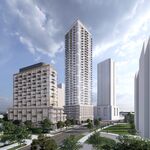Asterix
Active Member
With the stops north of Eglinton, there is at least a number of people getting off the train to make room for new passengers. At the secondary stops south of Eglinton (Davisville, Summerhill, and Rosedale) this is not the case.
The fundamental point is that short turning trains at Eglinton reduces capacity north of Eglinton while doing nothing to change the capacity south of Eglinton.
Unlike the Spadina line north of St Clair, there simply is not the spare capacity north of Eglinton on the Yonge line for any kind of cut.




